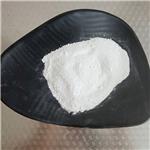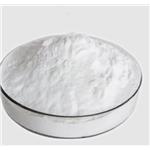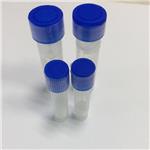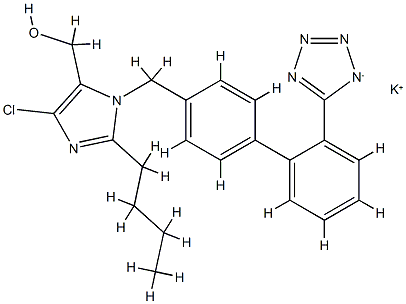
Erythropoietin
- Product NameErythropoietin
- CAS11096-26-7
- CBNumberCB8290955
- MFC22H22ClKN6O
- MW461.00098
- EINECS234-317-2
- MDL NumberMFCD00131025
- MOL File11096-26-7.mol
- MSDS FileSDS
Chemical Properties
| storage temp. | -20°C |
| form | lyophilized powder |
| color | white |
| biological source | rabbit |
| Merck | 13,3722 |
| InChI | InChI=1S/C22H22ClN6O.K/c1-2-3-8-20-24-21(23)19(14-30)29(20)13-15-9-11-16(12-10-15)17-6-4-5-7-18(17)22-25-27-28-26-22;/h4-7,9-12,30H,2-3,8,13-14H2,1H3;/q-1;+1 |
| InChIKey | OXCMYAYHXIHQOA-UHFFFAOYSA-N |
| EWG's Food Scores | 1 |
| NCI Dictionary of Cancer Terms | erythropoietin |
| FDA UNII | 64FS3BFH5W |
| ATC code | B03XA01 |
| UNSPSC Code | 41116107 |
| NACRES | NA.77 |
Safety
| WGK Germany | 3 |
| RTECS | KF5885000 |
| F | 10-21 |
| HS Code | 3504009000 |
Erythropoietin Price
| Product number | Packaging | Price | Product description | Buy |
|---|---|---|---|---|
| Sigma-Aldrich SAB1305773 | 400μl | $481 | ANTI-ERYTHROPOIETIN(C-TERMINAL) antibody produced in rabbit IgG fraction of antiserum, buffered aqueous solution |
Buy |
| Sigma-Aldrich H5166 | 10μg | $619 | Erythropoietin human EPO,recombinant,expressedinHEK293cells,suitableforcellculture |
Buy |
| Alfa Aesar J67439 | 2kilounit | $295 | Erythropoietin alpha, human |
Buy |
| Alfa Aesar J67439 | 500units | $133 | Erythropoietin alpha, human |
Buy |
| Usbiological E3455-15 | 500ug | $465 | Erythropoietin |
Buy |
Erythropoietin Chemical Properties,Usage,Production
Discovery
This is the primary regulator of erythropoiesis. It is produced predominantly in the fetal liver and the adult kidney to promote the survival, proliferation, and differentiation of erythroid progenitor cells. Other nonhematopoietic roles include neuro-, cardio-, and reno-protection as well as wound healing. The relationship between anemia and hypoxia/atmospheric pressure was perceived around the 16th century, predicted experimentally by Carnot and Deflandre. The tentative name erythropoietin (EPO) was proposed independently by Komiya and by Bonsdorff and Jalavisto. Reissmann and Erslev confirmed the humoral activity in the blood. Jacobson and colleagues found that the kidney primarily produced EPO. The human EPO protein was finally purified directly from approximately 2550 L of human urine of patients with aplastic anemia. The subsequent molecular cloning of cDNA and the genomic DNA of human EPO was accomplished concurrently by two research groups in 1985.Structure
Mature EPOs are heavily glycosylated to reach 30%–40% (w/w) of the whole molecule. The terminal sialic acids provide stability in the circulation, and are essential for in vivo activity. The tertiary structure displays four-α-helical bundles shared among typical cytokines. The mature human EPO consists of 165 aa residues after posttranslational cleavage of an Arg166 at the C-terminus. Mr. of human EPO polypeptide backbone is 18.2 kDa, 34 kDa on SDS-PAGE (glycosylated native form), or more than 40 kDa (fully glycosylated recombinant EPO expressed by CHO cells). The isoelectric point (pH 3–5) varies depending on glycosylation. The level of biological activity is reasonable against short-term heat treatment, 6M urea, 6M GuHCl, or ordinary surfactants, when renaturation is performed properly.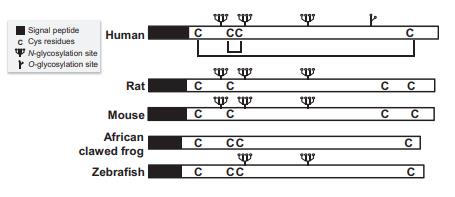
Gene, mRNA, and precursor
The human EPO gene is located in the q11 to q22 region of chromosome 7 [NC_000007. (100,720, 800.100723700)]. Human EPO mRNA encodes a 193-aa polypeptide. Heterogeneity in the size of EPO mRNA has been reported; for example, EPO mRNA of larger size is found in the brain. The production sites vary depending on either species or ontogenic stages. In mammals, the predominant sites of EPO production shift from the fetal liver to the adult kidney along with the transition of hematopoietic tissues. In mice, hepatocytes in the fetus and adult renal cells in the peritubular interstitium produce EPO. In nonmammalian vertebrates, EPO is generated predominantly in the lung and the liver of the African clawed toad. In teleost fish, the heart is one of the major production sites of EPO. EPO for murine primitive erythropoiesis is produced in neuroepithelial and neural crest cells.Synthesis and release
Human EPO regulates erythropoiesis in a hypoxiainducible manner. Levels of HIF-1α in EPO-producing cellsincrease exponentially as O2 concentration declines because ubiquitination and proteasomal degradation of HIF-1αdecrease. Then EPO expression is directly upregulated by the transcriptional activation via interaction of a 30 enhancer complex with the 50 promoter. The number of EPO-producing cells in the human kidney correlates positively with circulating levels of EPO, but the range of EPO expression per cell has not been determined. Ninety percent of the circulating EPO originates from the kidneys and the rest from various organs, including the liver, brain, spleen, lung, and testis.Receptors
The EPO receptor (EPOR) is a glycoprotein that belongs to the type I superfamily of single-transmembrane cytokine receptors. A soluble form of EPOR lacking a transmembrane region generated by the alternative splicing of EPOR mRNA is found in human blood. The tertiary structure of human EPO and the homodimerized EPOR complex has been determined. Intracellular EPO-EPOR signaling is triggered by the binding of EPO, and EPORs homodimerize to activate a cascade of JAK2 and STAT3/5, PI3K, and/or RAS/ MAPK.Agonists and Antagonists
Small mimetic peptides such as EMP111 and their derivatives, agonistic antibodies to EPOR that mimic the conformation of EPO-EPOR binding (Ab12.6, also known as ABT007), and EPO fused with hybrid immunoglobulin Fc (EPO-hyFc), have been reported. Other than specific antibodies to EPO or EPOR, soluble EPOR inhibits the EPO/EPOR-dependent cell proliferation in glioma cells.Biological functions
As a primary target of EPO for erythropoiesis, EPOR is expressed in the organs of hematopoiesis, including the fetal liver as well as the adult bone marrow and spleen. EPO-EPOR signaling regulates the proliferation/differentiation and survival of the erythroid progenitors, providing an important stage-specific function of erythroid differentiation. The numbers of EPOR expressed in various cells are relatively low and range between 100 and 3000 per cell with the binding affinity (ED50) to EPO ranging from 0.1–3 nM. A wide distribution of EPOR expression is confirmed on renal cells, endothelial cells, cardiomyocytes, the brain, and peripheral nervous system where EPO may exert pleiotropic or antiapoptotic effects.Clinical implications
EPO maintains the number of circulating red blood cells, that is, hemoglobin levels, by stimulating the proliferation and differentiation of erythrocyte progenitors in the bone marrow. Therefore, EPO is mainly administered as hormonal replacement therapy to patients with renal failure who have experienced the compromised production of EPO. Additionally, the nonhemopoietic role of erythropoietin has been evaluated in clinical trials, including the reduction of hyperglycemia and the retardation of proliferative retinopathy in diabetic patients.Use for diagnosis and treatment
Recombinant human EPO has been among themost successful therapeutic biologics. Originally, epoetin-α and -β produced by CHO cells were developed and launched for the treatment of chronic renal anemia to achieve optimal hemoglobin levels and improve the QOL. Its application has extended to cancer-related anemia involving chemotherapy/radiation, inflammatory bowel disease (Crohn’s disease and ulcer colitis), and others. The circulating levels of human EPO have been determined by RIA or ELISA for the diagnosis of different types of anemia. The second generation of erythropoiesis-stimulating agents (ESAs), such as a long-acting analog darbepoetin with two additional glycans andits various generics,is following the first generation. Doping with EPO has become a serious issue in athletics competitions.Description
Recombinant erythropoietin (EPO) is currently indicated for use only in anemia associated with renal transplant or end-stage renal disease. Widened indications for use in other forms of anemia, accompanied by price reductions as a result of keen competition, have been projected for EPO in the future.Originator
Amgen (USA)Uses
Erythropoietin can be used in biological study of its attenuation of cardiac dysfunction in rats by inhibiting endoplasmic reticulum stress-induced diabetic cardiomyopathy.brand name
EprexGeneral Description
EPO has been cloned from various species including human, murine, canine, and others. The mature proteins from the various species are highly conserved and exhibit greater than 80% amino acid sequence identity. EPO contains three N-linked glycosylation sites. The glycosylation of erythropoietin is required for the biological activities of erythropoietin in vivo.Biochem/physiol Actions
Erythropoietin (EPO), produced primarily by the kidney, is the primary regulatory factor of erythropoiesis. It promotes the proliferation, differentiation, and survival of the erythroid progenitors. Erythropoietin stimulates erythropoiesis by inducing growth and differentiation of burst forming units and colony forming units into mature red blood cells. EPO produced by kidney cells is increased in response to hypoxia or anemia. The biological effects of erythropoietin are mediated by the erythropoietin receptor, which binds EPO with high affinity and is a potent EPO antagonist.Preparation Products And Raw materials
Raw materials
Erythropoietin Supplier
Global(104)Suppliers
| Supplier | Tel | Country | ProdList | Advantage | ||
|---|---|---|---|---|---|---|
| +8616632313095 | xinlikeji01@qdxlchem.com | China | 124 | 58 | ||
| +86-13082019107 +86-13082019107 |
admin@flanderff.com | China | 244 | 58 | ||
| +8613363081709 | 3957328362@qq.com | China | 300 | 58 | ||
| +8613363867578 | nancyyuan133@163.com | China | 152 | 58 | ||
| +86-0371-55170693 +86-19937530512 |
info@tianfuchem.com | China | 21632 | 55 | ||
| +86-15013270415 +86-15013270415 |
honestchemical@foxmail.com | China | 246 | 58 | ||
| 18871490254 | linda@hubeijusheng.com | CHINA | 28172 | 58 | ||
| +1-631-485-4226 | inquiry@bocsci.com | United States | 19552 | 58 | ||
| +8617531153977 | allison@yan-xi.com | China | 5855 | 58 | ||
| +8618330912755 | sale2@hbyalin.com | China | 1658 | 58 |
Related articles
Erythropoietin: Neuroprotective Function, Therapeutic Effect in Glaucoma and Side Effects
Erythropoietin's neuroprotective benefits in glaucoma are promising, but its therapy entails risks like increased blood viscosity and potential neurological and tumor-related complications.
Nov 8,2024
A glycoprotein cytokine: Erythropoietin
Erythropoietin (EPO) is the main regulator of red blood cell production. It is secreted mainly by the kidneys in response to cellular hypoxia.
Oct 25,2023
View Lastest Price from Erythropoietin manufacturers
11096-26-7, ErythropoietinRelated Search
- TRIS(2,2,6,6-TETRAMETHYL-3,5-HEPTANEDIONATO)EUROPIUM(III)
- Tosylmethyl isocyanide
- SALCOMINE
- 2,4-PENTANEDIONE, SILVER DERIVATIVE
- TERT-BUTYL ISOCYANIDE
- COBALT(II) ACETYLACETONATE
- DICHLORO(ETHYLENEDIAMINE)PLATINUM(II)
- METHYL ISOCYANOACETATE
- Aluminum acetylacetonate
- Cupric acetylacetonate
1of4
PROMPT×
PROMPT
The What'sApp is temporarily not supported in mainland China
The What'sApp is temporarily not supported in mainland China
Cancel
Determine
